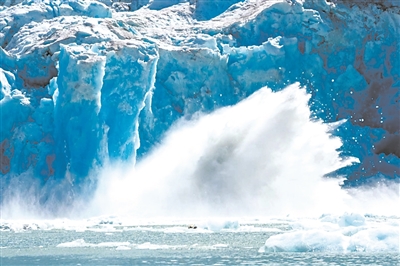Global average sea level reaches its highest point since satellite records began

The number of phytoplankton is declining.

Antarctic ice is melting.

Algal bloom broke out.

Ocean warming causes coral reefs to bleach.
Since the 1970s, the ocean has absorbed more than 90% of the world's excess heat and one-third of its carbon emissions. But as human activities intensify and greenhouse gas emissions increase, sea temperatures have continued to rise in recent decades. In June this year, UNESCO reported that the rate of ocean warming has doubled in 20 years.
The British "New Scientist" website recently reported that more and more evidence shows that extreme temperatures are causing serious damage to the ocean and the organisms within it, pushing the ocean to the brink of disaster.
Global sea surface temperatures break records repeatedly
Gregory Johnson, a researcher at the National Oceanic and Atmospheric Administration (NOAA), said that between 1993 and 2022, the global average sea surface temperature rose by about 0.42 ° C every ten years. However, starting from March 2023, the sea surface temperature has increased by about 0.28 ° C in just five months.
In June this year, data released by several international authoritative climate monitoring agencies around the world showed that the global average sea surface temperature continued to set new records for the same period. NOAA reported on June 13 that sea surface temperatures in most of the world's seas in May were higher than the historical average for the same period, with sea surface temperatures in the tropical Atlantic reaching record highs.
Climate change may be the "chief culprit" of increasing ocean temperatures. In 2023, El Niño climatic conditions will form in the tropical Pacific for the first time in seven years, raising sea surface temperatures in the region. Petri Talas, Secretary-General of the World Meteorological Organization, pointed out that the El Niño phenomenon has greatly increased the possibility that the sea surface will break temperature records again, triggering more extreme temperatures in many regions around the world.
Seriously affect marine ecosystems
Rising ocean temperatures have significantly affected marine ecosystems. From January 2023 to May 2024, large-scale coral reef bleaching events occurred in at least 62 countries and regions around the world-this is a direct result of seawater warming: when the ocean temperature is about 1 ° C higher than the long-term summer temperature and lasts for 4-6 weeks, coral bleaching will occur.
Other changes are equally worrying. When Florida State University marine ecologist Dean Grubbs and others investigated the cause of death of saw rays in the area, they found that a large number of toxic algae grew and multiplied on the seabed. They analyzed that the 2023 marine heat wave in Florida disrupted the ecosystem, causing toxic algae to flourish, and more than 50 different fish species showed symptoms of neurotoxin poisoning. Saw rays may be the most severely affected large marine species.
Algal blooms are rampant around the world. One study showed that from 2003 to 2020, the coverage of algal blooms increased by 13.2%, and the frequency increased by nearly 60%. In June 2023, an algal bloom in the North Atlantic and North Sea region turned the sea water a dirty orange that can be seen from space. The area has experienced extreme temperatures over the past 18 months, and in June this year, temperatures in the area were 5 ° C above normal. NOAA scientists say the area is "feverish."
Angus Atkinson of the Plymouth Marine Laboratory in the UK said that the sea water is naturally stratified, with warmer, fresh, oxygen-rich water near the surface layer; cooler, salty, nutrient-rich water at the lower level. As ocean temperatures rise, fusion between water layers decreases, making it difficult for nutrients to rise to the surface and for oxygen to sink into the deep sea. The nutrients received by phytoplankton are greatly reduced. In April 2023, global phytoplankton and bacterial productivity dropped by 22%. The decline in phytoplankton production was particularly significant in the North Atlantic. Not only are there fewer phytoplankton, they are also smaller, and crustacean zooplankton cannot feed on them, which in turn leads to a decline in the production of mackerel, cod and herring that feed on zooplankton.
Accelerating melting of ice sheets raises sea levels
In July this year, scientists from the British Antarctic Survey published a study in the journal Nature Geoscience that global warming has caused sea temperatures to rise, the Antarctic ice sheet is accelerating melting, and global sea levels are rising, putting coastal areas at risk.
Before 2015, the range of Antarctic sea ice expanded every winter; but in 2016, Antarctic sea ice suddenly experienced a "collapse", and then broke the historical minimum record three times. In 2023, sea ice coverage will drop to 16.96 million square kilometers, the lowest level in history.
Antarctic bottom water is also declining. Antarctic bottom water is a deep cold, high-density water mass around Antarctica. It is formed in the Ross Sea and the Weddell Sea, carrying oxygen and nutrients to the depths of the Pacific and Atlantic Ocean. But increased melt water and reduced sea ice mean less salinity in Antarctic waters, making it more difficult to sink. Research shows that over the past 30 years, the amount of water in the Weddell seabed has decreased by more than 20%, and it has warmed four times faster than other sea areas.
Warming sea waters will cause sea levels to rise. In 2023, global average sea level will reach its highest point since satellite records began in 1993. Based on current trends, it may rise by another 20 centimeters by 2050, increasing the frequency and severity of floods in coastal areas.
Christopher, a scientist at the National Center for Atmospheric Research, analyzed that global warming has caused sea surface temperatures to rise, creating conditions for the formation of stronger storms. In July this year, Hurricane Beryl hit the Caribbean Sea, the Gulf of Mexico and the United States, killing many people. It was also the strongest hurricane in history for the same period since records began in 1851.
(Photo source of this article: New Scientist website)







